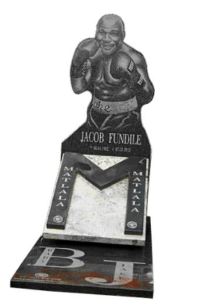It’s called “the existential slap”: that moment when a person diagnosed with a terminal illness realizes that death is near. The Atlantic takes a look at what psychologists are learning about how we react to that knowledge. One thing they discovered is that the Elisabeth Kübler-Ross’ five stages are not quite as linear as once thought. People can toggle between a sense of denial and of acceptance. “You have to live with awareness of dying, and at the same time balance it against staying engaged in life,” a doctor explains. “It’s being able to hold that duality—which we call double awareness—that we think is a fundamental task.”

What happens after we’re dead? We’re not sure, but some people really go out of their way to make sure they’re remembered. The Sowetan Sunday Times has a story about the current vogue for gaudy headstones. The boxer Baby Jake Matala’s headstone is a life-sized representation of the boxer in a defensive pose, gloved fists at the ready. But our favorite is South African TV star Joe Mafela, whose grave has a flat-screen TV, coffee table, and couch, all carved in granite.

In New Orleans, the dead are interred above ground, but that doesn’t mean that death doesn’t come bubbling up from underground. The Times-Picayune takes a look at the odd objects that show up in the city’s storm drains, an inventory that includes guns, power drills, Mardi Gras beads, and a pile of bones.


Leave a Reply